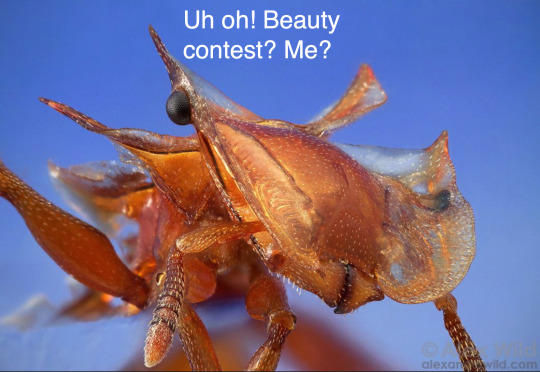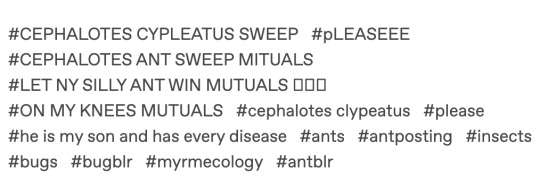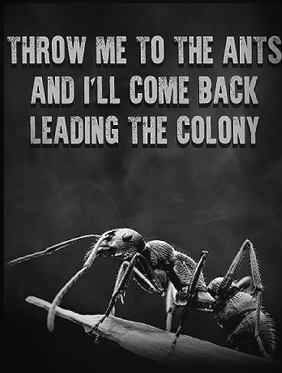#Cephalotes
Explore tagged Tumblr posts
Text

A colony of gliding ants (Cephalotes atratus) in Ecuador
by Graham Wise
#gliding ants#ants#cephalotes atratus#cephalotes#Formicidae#Hymenoptera#insecta#arthropoda#wildlife: ecuador#wildlife: south america
75 notes
·
View notes
Text
Checking in with Cephalotes clypeatus, the Amber Turtle Ant's Bid to Win the Ant Beauty Contest

Hey lil turtle ant! How is the beauty contest going?

Yes, you! You are one of the most lovely ants!

That's not true! You have such a lovely shield-shaped head.

So you aren't worried about if you win or not? You even have fans cheering you on! (@polarized-here)



I know you will little turtle ant! Vote for Cephalotes clypeatus!
#ant poll#ant contest#ant beauty contest#Cephalotes clypeatus#Cephalotes#ants#ant#turtle ant#ant posting#antblr#bugblr#entomology#insects#myrmecology#antposting#invertebrates#antkeeping#cool bugs#cute bugs
36 notes
·
View notes
Text
Throw me to the ants and I'll block the door with my THICK HEAD!

Thinking of becoming a guy that thinks wolves are the most badass and aspirational animal, but about ants. Like wearing t-shirts about being loyal to my Queen and training to bench 5x my bodyweight. Studying ant warfare. Posting shit like this

29K notes
·
View notes
Text

Siphamia cephalotes, Wood's Siphonfish. St Leonard's Jetty, Port Phillip, Victoria.
4 notes
·
View notes
Text
if king boo had an animal sona it'd be an octopus do you see my vision here

#Guys listen please guys please you need to understand me#i need to spread. my cephalotism#Tbh more accurately he would probably be a cirrate octopus#but the incirrates are my favorites so.. ya#king boo#you are GOING to perceive#who wanna be my mutual i will post octopus /j
19 notes
·
View notes
Text
Obnovující se krajina po požáru svědčí suchomilným druhům brouků
V květnu 2012 zasáhl požár přibližně 165 hektarů lesa v oblasti Moravské Sahary. Výzkum ukázal, že požár měl pozitivní dopad na obnovu biodiverzity. Vědci a vědkyně z Lesnické a dřevařské a Agronomické fakulty MENDELU pod vedením Emanuela Kuly se zaměřili na to, jak požár a následné lesnické zásahy ovlivňují společenstva střevlíkovitých brouků v písčitých lesích nacházející se na jihu Moravy.…
#Amara fulva#biologická rozmanitost#Broscus cephalotes#Cicindela hybrida#Cymindis macularis#Harpalus flavescens#lesní požáry#Moravská Sahara#Natura 2000#ochrana přírody#otevřené biotopy
0 notes
Text

Cephalotes atratus | turtle ant
MY OVARIES!!!!!!
31K notes
·
View notes
Text

On the way to the mushroom farm (Atta cephalotes)
69 notes
·
View notes
Text

file: Cephalotes atratus casent0173663 profile 1.jpg
292 notes
·
View notes
Text

Leafcutter ant (Atta cephalotes). The Entomologist's Text Book. Written and illustrated by John Obadiah Westwood. 1838.
Internet Archive
269 notes
·
View notes
Note
Just looked through your stimboard tag (love all of them) but I noticed you don’t have a turtle ant (Cephalotes varians) one!
Could I request one for them? Not sure on a stim theme, so do whatever feels best for them









The forbidden oreo...
🕳️-🕳️-🕳️|🕳️-🐜-🕳️|🕳️-🕳️-🕳️
#Stimboard#Stim#Brown#Slime#Dirt#Clay#Cookie#bugblr#insectblr#bug#bugs#insect#insects#entomology#ant#ants#myrmecology
61 notes
·
View notes
Text
She's a cutting machine! Like a circle cutter with legs come to life!
Her body is designed to cut and haul maximum LEAF.
What a triumph!
Oh you might not like it. You might get mad. But THIS is what peak performance looks like:

The book “Gardening Ants: The Attines” (Weber) is old but it has so many banger illustrations. Here is one showing the size difference in Atta cephalotes minors and majors. This difference is entirely caused by how the ants are fed and cared for. Ants have so much variability in gene expression and they use it to shape their population to fit the work that needs to be done. (I love the naturalistic placement of the minor on the major’s head, they do hang out like this.)
When atta are cutting a leaf they make stridulations (vibrations too hight-pitched for human hearing) by moving their exoskeleton. This noise isn't just a result of the cutting, it's an extra noise that carries through the plant, letting other ants know the quality of the leaf. The higher quality the leaf the more intense the sounds she will make calling more ants to the place where the leaves are at the perfect level of development for fungus farming.
Wonder if plants are alarmed by this?
#ants#bugblr#antposting#bugs#ant#antblr#myrmecology#invertebrates#insects#antkeeping#atta#Atta cephalotes#leafcutter ants#big head#sisters
204 notes
·
View notes
Text



bug comms. atta cephalotes with the coloration of chocolant from bugsnax, chalcophora virginiensis, and cephonodes hylas
taking more slots for these, 10 usd base price but will increase detail/add shading if tipped
38 notes
·
View notes
Text
Férjem látott egy bogarat, valószínűleg nagy selymesfutó, de sajnos nem

és sajnos nem
árvafutonc (Amblystomus) nem Erichson, 1837
és nem
gödörkés lomhafutó (Harpalus autumnalis) Duftschmid, 1812
és nem
busafejű selymesfutó (Harpalus cephalotes cephalotes) Fairmaire & Laboulbène, 1854
és nem
nagyfejű tömzsifutó (Pangus scaritides) Sturm, 1818
és nem
pompás törpefutonc (Acupalpus elegans) Dejean, 1829
és nem
karcsú kisdedfutó (Anthracus longicornis) Schaum, 1857
és nem
négyfoltos fövenyfutonc (Lionychus quadrillum) Duftschmid, 1812
és nem
busafejű posványfutonc (Badister dorsiger) Duftschmid, 1812
és nem
termetes kisfutó (Limodromus longiventris) Mannerheim, 1825
és nem
sutafutó (Polistichus) nem Bonelli, 1810
de azért aranyos.
21 notes
·
View notes
Text
There's tons of different wasps I would be ecstatic to see in person. A few of them are like, tropical or desert wasps, but, among the ones that are actually more general in terms of locale, one type I'm quite particular towards is the Ectemnius genus of Square-Headed Wasps.


[Image Sources: Bees Wasps & Ants Recording Society, and JungleDragon, Jeroen Hoppenbrouwers | Image IDs: Two photos of Ectemnius cephalotes, a black and yellow Square-Headed Wasp, as viewed with their rectangular faces as the focus of the shot /End IDs.]
... I'm sure you can guess why they call them that.
75 notes
·
View notes
Photo

🌏 Comprehensive catalogue of Queensland plants Brisbane, A. J. Cumming, government printer[pref. 1909] Original source Image description: Historical botanical illustration depicting three Cyperaceae species native to Queensland, Australia: Cyperus pumilus, C. cephalotes, and C. cuspidatus. Each plant is drawn with detailed emphasis on their root systems, slender stems, and distinctive cluster-like inflorescences. The image includes smaller inset sketches highlighting specific features such as glumes and nutlets. The page is from a 1909 government-printed catalogue, with scientific names and authorship listed below the illustrations. The drawings are finely detailed in black ink on a cream background, emphasizing morphological traits for plant identification.
18 notes
·
View notes